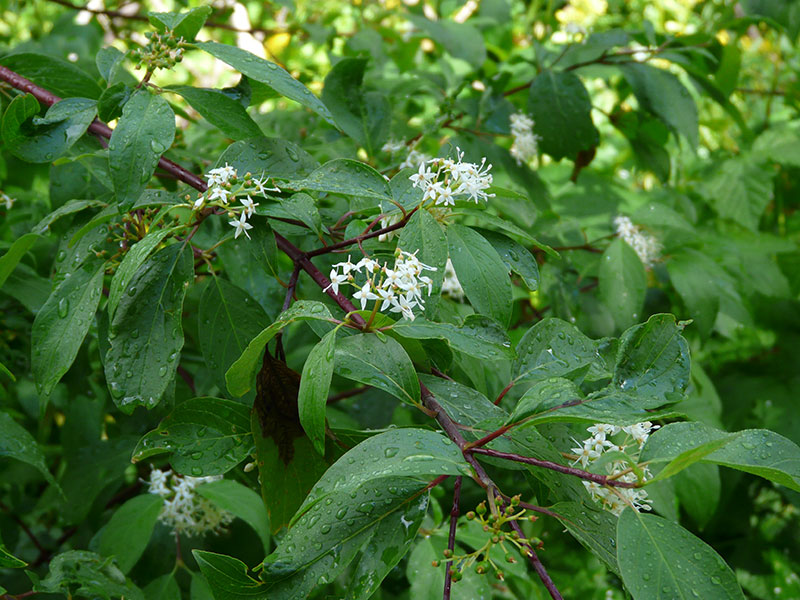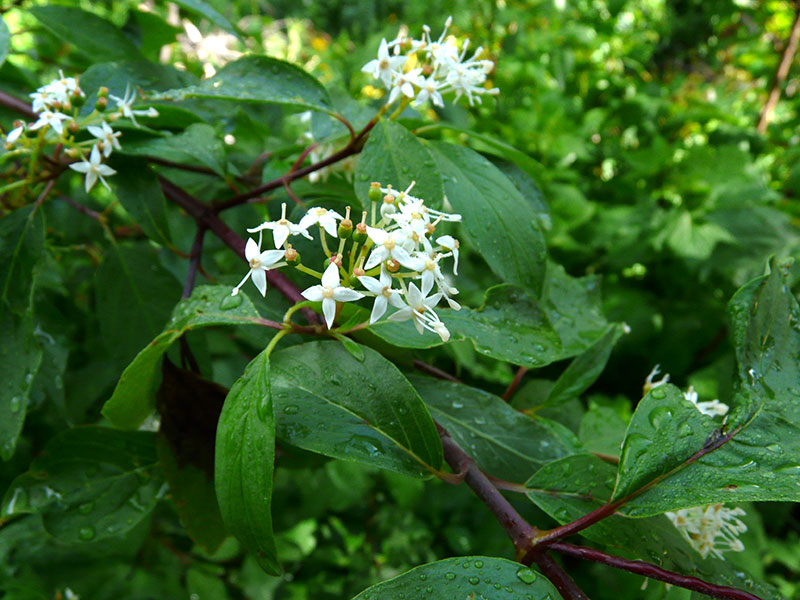Cornus sericea / red osier dogwood
- shrub with opposite branching and red bark, brightest in fall/winter
- common along streams especially
- small white flowers, 4 petals, in clusters
- white or blue-ish white berries in fall
- opposite leaves with parallel veins
Synonym: Cornus stolonifera
Also known as: red-stick dogwood, American dogwood, creek dogwood, red dogwood, red twig dogwood
Red osier dogwood is a multi-stemmed, erect or spreading shrub, up to 20 feet tall. The most distinguishing feature of the plant is the color of the stems – red to a reddish purple from summer through fall, becoming a bright red in the winter when the leaves have fallen. As in all dogwoods, the leaves and branches are opposite, the leaves are oval shaped with smooth edges, and the leaf veins branch off the midrib then become parallel to each other for the length of the leaf.
These shrubs are happiest in moist areas such as floodplains and stream banks where they are quite tolerant of flooding. Although that puts them at the bottoms of many of our canyons, they may also occasionally be found in uplands, including in forest understories. In any case, they grow best in rich, moist, poorly-drained soils.
Besides its stem color, red osier dogwood is also quite noteworthy in spring for its flowers. These are small but bright white with 4 petals and 4 stamens, and are densely clustered in terminal cymes. There are up to 30 individual flowers per inflorescence. The stamens are quite long with respect to the flower and there is a single pistil in the center, somewhat shorter than the stamens. The actual time of flowering is determined by temperature patterns.
However, the stamens are not always visible, as you can see in the gallery photos. This is actually an interesting conundrum since the flowers are “perfect”, meaning that they all have both male and female structures. This is a common feature in dogwoods, it seems, and makes for interesting high-speed videography. In the related species, C. canadensis (bunchberry), for example, the stamens are initially folded under a flap which, upon physical stimulation of the stigma, dramatically (but on a very small scale) explodes, releasing the pollen onto whichever small insect did the stimulation (watch it here).
After pollination, the ovaries mature over the summer into small-ish white or bluish white berries. Propagation by seed is rather limited, however, partly due to seed predation and partly to poor germination rates. Rather, the major mode of propagation for this species is by stolons, stem suckers or rooting at stem or branch nodes in contact with soil.
Red osier dogwood is an important food for many mammals and birds, as well as providing cover. Moose, bighorn sheep, and elk browse the shoots — especially in winter — while the fruits are eaten by bears, small mammals and many bird species.
| Color | |
|---|---|
| Family | |
| Blossom size | |
| Inflorescence size | |
| Inflorescence type | |
| When? | |
| Where? |


